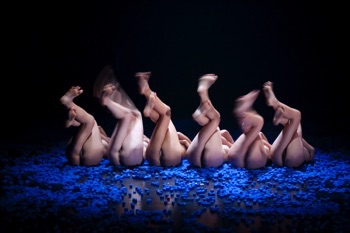

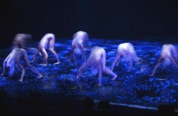
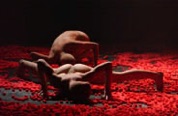
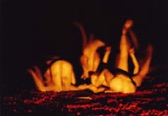
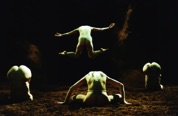
LUVOSmove® - Editta's memories
It's a hot summer day in 1984, we, the collective Vorgänge, are rehearsing new ideas in the outskirts of Salzburg, undecided about how to approach a new piece. Barely clothed, we roll around on the floor in bras and underpants, one of us rolls onto his neck, his knees next to his ears, someone else laughs out loud: "That looks like a phallus!" Beda, Ekke, Wolf, Annette, Anna, Marion and I roll into the same position: the first Luvos creature is born - the phalli (sic! we immediately thought of the plural, that's what it remained, a phallus is called "a phalli" from now on). Art production is not plannable, to perceive the creative moment and to spin it further, that's the trick.
We discover how isolated body parts mutate into peculiar beings from a sharply defined viewing perspective, We put on two records by Art Zoyd: "Musique pour l'Odyssée" and "Le Marriage du Ciel et de l'Enfer" - they fit perfectly. Powerful sounds and chasing rhythms of these compositions, described as chamber music for punks, contrast starkly with our creatures of naked body parts. A musical world opens up, which Beda Percht and I had recently discovered on the occasion of a concert of the French avant-garde rock formation in Salzburg. Thierry Zaboitzeff, one of the two composers of Art Zoyd, still creates the unmistakable Luvos sound world with his works.
We quickly understand two principles that define the Luvos world: de-individualized performers and naked bodies. Shame was not an issue in our group in the early 80s: male and female bodies pushed into each other, over each other, under each other. But, I can remember the different body smells, I knew with my eyes closed who was crawling, robbing, bouncing in front of me. That was familiar, even if not necessarily pleasant. But shame: no.
We, the collective Vorgänge, create a 23-minute piece together, the stage will be covered with peat (at that time no one thought of the damaging effects of peat mining), we smear our skin with Luvos healing earth, because Thomas Hinterberger, our lighting designer, is enthusiastic about the dust effect in the backlight. The premiere is planned for spring in Salzburg, too far away from those hot summer days in 1984 when we had made the surprising discoveries about Luvos, so we leave for further training in Senegal, taking lessons in African dance in Fanghoumé, a small village in the south of the country, led by the then already world-famous Grande Dame of African dance, Germaine Acogny, director of Maurice Béjart's dance center Mudra Afrique.
No electricity, no running water, too little to eat, lots of sand fleas and endless enriching impressions through life in the village community. Beda's host gift, a neckerchief from his mother's Pinzgau home, lays the foundation for a lifelong connection and friendship between Germaine Acogny, her husband Helmut Vogt and me.
But before that, we have to withstand a test: the premiere, or actually preview: We are invited to show our choreography in a forest close to the village, on the occasion of an important ceremony for the village - the dedication of this sacred grove in honor of the animist priestess Aloopho. Germaine Acogny, who is the granddaughter of Aloopho and who, we are told, is the reincarnation of Aloopho, and the village elders drink from a ritual drinking vessel. And so do we. Shy, impressed.
A clanking ghetto blaster hangs in the tree, our naked bodies would be
unacceptable to this Muslim village, so we put them in black leotards. Nevertheless, the illusion seems to be conveyed that strange creatures are screeching and flailing through the forest here. The reactions of the venerable round are intense. From this moment on, we atheists feel connected to this Aloopho and Germaine Acogny advises us to light a candle for her grandmother at every performance. This we do.
Back in Austria, the piece is premiered. By now it bears the title "Lufus", a word that alienates the name of the Luvos healing earth. It is condensed by Thomas Hinterberger's poetic light design, the bodies are again naked except for the string-tangas I sewed myself, several bags of peat cover the stage floor in the Kleines Theater Salzburg. It offers an ideal stage-audience situation that will be common to all Luvos pieces: The audience must sit frontally and have a perfect view of the dance floor, darkness in the room is a prerequisite, and the lighting moods are delicate and extremely precise. This is the only way to create alienation, deception, illusion and surprise.
"Lufus" is discovered by the Austrian television and is filmed for the most important cultural program of the time, "Kunststücke. During the late-evening nationwide broadcast, ORF receives numerous indignant calls about the shameless "art action. A good advertisement for us. Everyone is now talking about "Die Vorgänge".
I send the professional footage as an application to the most important European competition for contemporary choreography in Bagnolet near Paris - and we are invited. A flash, but also a clash. Finally it's our turn. Naked, dressed only in our self-made thongs, a tight bathing cap on our heads, we cross the hall to perform, passing dancers on ballet poles, very surreal. We are decorated with the prize for the most innovative choreography and receive ex aequo with Saburo Teshigawara the second prize of the competition. Le Figaro writes about us: "Victoire autrichienne", Austrian victory.
In the Paris subway, clips from the Lufus film adaptation are projected. Our butts are present everywhere on screens, we see how people stop. And we find this quite normal. A little bit great, but justified. A wonderful lightness accompanies us in these early years of surprising international success.
The Art Zoyd also see us in the subway, listen to their own music and are amazed who stole the music so easily and unabashedly. They are quite weird guys themselves and taken with our earth figures. Richard Castelli, the manager of Art Zoyd, who looks like Louis XIV, contacts us. How he found out the phone number of the landlady of our shared apartment, we still don't know. We had no telephone at that time. Negotiations in phone booths followed, new projects and live performances of Art Zoyd came about. Already then I was fascinated by Thierry Zaboitzeff, one of the two composers of the troupe. Today we are a couple, for a long time, and also work together artistically.
Until 1990 we, the collective Vorgänge, are on the road with our hit "Lufus" all over Europe and cause a big sensation. Only once we forget the candle for Aloopho.The performance at the Marstalltheater in Munich turns into a disaster, we collect our only very bad review.
Eleven years later, in 2001, "Luvos, vol. 2," my thirteenth full-length work. I ask myself: What comes to my mind about the Luvos idea today, sixteen years later? I had experienced on my own body what it meant to dance "Lufus." The challenge of sending my presence and precision into my toes, of being invisible as a person and precisely for that reason sending feelings and radiance into individual parts of the body - all this is familiar to me, I know the Luvos world from the inside.
Thierry Zaboitzeff composes five extreme, crazy pieces on the theme of genetic manipulation, which I proposed for this work. With this music in my pocket, I start rehearsing with five dancers. From now on, the Luvos ensemble is exclusively female. Barbara Motschiunik becomes an anchor in this ensemble, she is the one who always keeps her orientation in the complicated music, she counts everything, knows all the cues and invents the craziest positions with her extremely flexible body.
My first and most important decision - and a difference from the original choreography "Lufus": the face is never visible. Improvisations, for hours, for weeks. I only see buttocks, thighs, back, toes. These images haunt me even at night, I can't get rid of them.
For eight weeks, the five extremely limber, strong and supple dancers crawl around on the floor, always searching for the One: I am only interested in images in which one forgets the human being and glimpses new beings. Often a simple reduction that is more exciting than the extreme contortion - just a dangling hand, a swaying foot.
A sitting naked back without head looks like a big phallus.
A back supported by the neck without legs likewise.
Intertwined legs of dancers lying on their backs are seaweed to me; if they wander sideways lying on their backs, legs spread wide into straddle, I see spiders.
If they are stacked and intertwined, a butt becomes the head of this double beast, the legs arms. Five buttocks stacked on top of each other, rising and falling in rhythm with the breath, look like a pyramid of eyeless heads.
The movement repertoire emerges, we meanwhile use the terms I invented as if we were speaking our own language: Landscape, Ur-Lufus, Spiders, Rolls, Doppelvieh, Swan, Flower, Bauchflügerl, Rückenbretter, Legforest, Algen, Hendl, Küken, Ass-Heap ...
The piece "Luvos, vol. 2" is radically reduced: Darkness, slowness, almost naked bodies on a red background, weird music, extremely focused light. A 50-minute long breath before the final destruction.
The equipment of all future Luvos pieces establishes itself: thongs, now from Palmers, skin-colored bonnets, red foam flakes instead of the meat scraps I fantasized about, and our notorious, repair-prone light rails invented by Thomas Hinterberger. All packed in huge, thick and bulky bags, we are happily on the road with "Luvos, vol. 2" for eleven years. We are quickly spoiled by success, which is guaranteed like the fact that Sunday is followed by Monday. We travel from Siberia and Moscow to Thessaloniki, Cyprus, Jerusalem and Marseille, and to many other wonderful venues throughout Europe, all the way to Saalfelden in the Austrian mountains.
But I'm also very much behind getting the quality right, and insist on the greatest possible precision in the musicality, in the spacing on stage, in the movement details.The light has to fit with extreme accuracy, even for the fiftieth guest performance. The light must fit with millimeter precision, even for the fiftieth guest performance. A lot of time must be spent on ensuring that the minimal light, this play with theatrical fog and darkness, is adapted to the theater in question, so that the bodies do not appear naked and human, but nevertheless every muscle movement remains visible.
This is the basis, the grammar, so to speak, of Luvos.But the magic comes from the non-verbal communication of the dancers, this joint breathing and radiating, as if not several but a single body were moving here. The own ego is forgotten, or rather, the ego extends over the group, becomes one with the others. If this common buzzing is missing for some reason - perhaps because it was too cold, or technicians are staring at the bosoms from the side, or the menstrual pain is great, the absorption of the individual into the common is missing, then I am dissatisfied.
To help the dancers, I invent a ritual: the audience is already pressing for admission, the Luvos dancers are lying on the stage covered in foam flakes, but I still have to briefly tell a new chapter of my continuation story, about Vladimir, the little Luvos ghost with a long tail, who has all kinds of mischief in his head and accompanies us to all guest performances.
Then a kiss on the forehead and a run to the technical room. Doors open.
The longer a dancer experiences Luvos, the more she develops it, becomes a specialist. Sandra Hofstötter will perform the Luvos pieces from 2001 to 2017, Anna Maria Müller from 2006 to the present; Martyna Lorenc represents the next generation, she too has been with us since 2012.
An enormous amount of experience has accumulated in the bodies and presence of these women, a kind of fine motor skills that encompasses the whole body and goes beyond the purely physical. They perform in multi-tasking mode. One part has to function with mathematical precision, counting, reacting to music cues, landing on a light position to the millimeter, keeping spatial orientation - all without ever being allowed to lift their eyes or even their heads. And the other part puts the emotion into individual body parts, communicating with the audience through toes and fingers, butts and shoulders.
Actually it is like this, and I understand this only after the first invitations to hip puppet and figure theater festivals in Edinburgh or Tallinn:
The dancer becomes the puppeteer, her own body is her puppet, her marionette: bored phalli, nervous spiders, tender algae. Buttocks become heads, looking to the right, to the left, hands crawling like insects over the butt-face, itching and scratching. The phalli laugh by shaking the upper body standing on the shoulders.
The particularly experienced among the Luvos dancers have internalized this game with alienation through their body parts. Although it feels completely different to them, they know what image, what association the new contortion just invented might produce for the audience side, experience it from the inside, so to speak. Masterful.
2012. Now I wonder: What happens when a human figure enters the Luvos world? Will illusion and alienation be preserved?
"planet LUVOS": A ship sinks, the crew sinks into an underwater world, are absorbed by it, merge into it, live on through it and in it. A takeover by nature.
The working method is now no longer improvisation, as it was at the beginning of "Luvos, vol. 2", but precise, purposeful research from the very beginning. Together with the seven dancers, I find new creatures, through further contortions, restrictions and interweavings of bodies . The large ensemble and the visually extremely strong lighting design by Peter Thalhamer create large, intense images of skin-colored creatures on a blue background, they incarnate again Phalli, Legforest, Spiders and Rolls, joined by Worm, Superspider, X-animals, Crab, Supercat, Elephants, Headstand, Leopards and Final-Animal.
In 2014, Thierry Zaboitzeff is playing his solo concert at a multi-day prog rock festival in the mountains of Portugal, and I'm with him. We are both waiting in the auditorium for his equipment to be set up when the fantastic concert pianist AyseDeniz Göckcin won't stop rehearsing her runs and just won't clear the stage in time. I sink and suddenly see a piano concert with AyseDeniz surrounded by Luvos creatures. The starting starting point of "CLOSE UP", premiere will be in 2015 at the KosmosTheater in Vienna.
Within three days of non-stop improvisation, both on the grand piano by AyseDeniz and by the five experienced Luvos dancers, the structure of the piece is set: the Luvos creatures are materialized nightmares of the pianist trapped in the constraints of high culture.
I give AyseDeniz as an improvisational brief and musical leitmotif Thierry Zaboitzeff's composition "Kombat," originally written for an electric bass guitar, on which she finds multiple variations. In addition, she develops piano versions of other compositions by Zaboitzeff as well as her own.
The interweaving of a piano concerto, which must first be written in rehearsals, and the choreography about the invasion of this very concerto by Luvos beings, is a great challenge for me. How to communicate with my dancers - all clear. But how with this young woman highly trained from child prodigy to solo pianist? A tightrope act. But a good, emotional one, since I grew up surrounded by piano music.
Anna Maria Müller, who performed and toured "Luvos, vol. 2" but could not be present at "planet LUVOS" because she had become a mother, rejoins the team of dancers in "CLOSE UP". Her son is now five years old and she decides to return to the stage. What was previously a no-go in the Luvos world now becomes possible: a solo. To an alienated quote from Beethoven's Moonlight Sonata. It becomes one of the most touching moments of "CLOSE UP". This delicate headless creature on long, unsteady legs, is caught, carried and protected by a community of sister beings.
When AyseDeniz Gökçin was replaced by the French pianist Cécile Thévenot in 2017, a new dimension opened up, as this musician is experienced in acting and especially in dealing with puppet theater - ideal for my concern. The communication between the protagonist and the Luvos beings becomes even more intense, the exchange between live music and movement even more permeable. Close Up 2.0, another step towards the next rung on the ladder of development.
Only short Luvos break. Over the years, I have remained in close contact with Germaine Acogny, often touring Senegal with other pieces and also visiting her dance center near Dakar, the École des Sables.
In 2020, I am overcome with the need to make a connection from 1985, the premiere of "Lufus", to my present Luvos world, which has evolved since then.
Germaine, Helmut, may we come?
Oui!
And if I gave the piece the name of the village of that time, "Fanghoumé"?
Bonne idée!
To relive the roots of the beginnings, that will be an incisive experience - a whole choreographer's life later, so to speak.
And, of course, to go one step further again.
For almost naked bodies are even less of an option in 2020 than they were in 1985; political Islam has also gained influence in Senegal.
In "Fanghoumé" and its further development "Hydráos," the female bodies are covered from the crown of the head to the tips of the toes, skin-tight green overalls from China make it possible. Grinchies are the names of the three dancers Anna Maria Müller, Martyna Lorenc and Sonia Borkowicz.
"Clothed is the new naked", the Salzburger Nachrichten will write at the following Salzburg premiere, and indeed, I like this antithesis to the now already ebbing fashion trend of nudity on the dance stages.
With the premiere of "Fanghoumé" in Senegal and "Hydráos" in Europe, not only a geographical circle is closed, but also the widely spread social relationship diagram of my life as an artist is formed:
Thierry Zaboitzeff writes the music, Anna Maria Müller is on the road with me, Germaine Acogny presents me with a premiere gift, Zapo, the wife of dance legend Jean Babilée, with whom I was privileged to work in my early days, is our technician in Africa, Thomas Hinterberger is still our lighting designer, and on the choreographic level, too, the lines from so many years run together: a best of.
Next? I don't know. Something will come along.
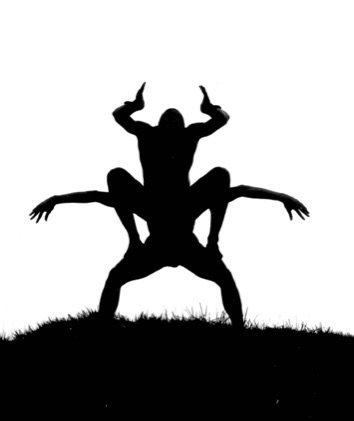
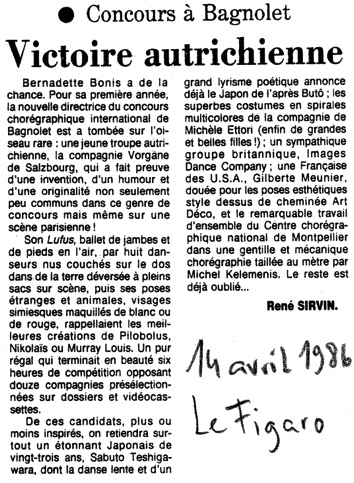

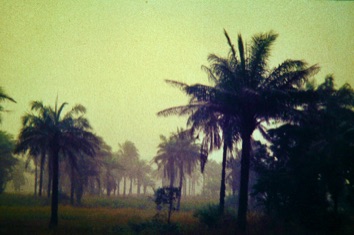

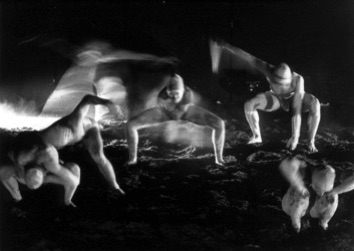
one of the Phalli
rehearsals in the marshs of Salzburg
sacred forest of Aloopho
Germaine Acogny in 1985
Photo: Nöbauer
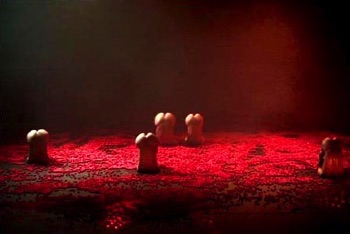


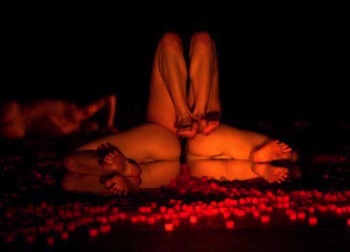
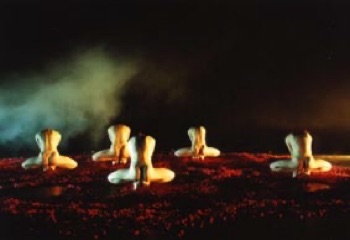
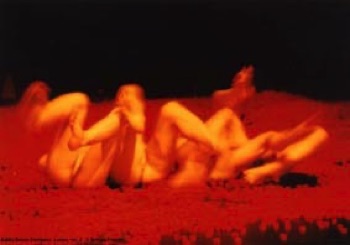
Phalli, Photo: Moser
Swan, Photo: Moser
Ass-Heap, Photo: Hörl
Gottesanbeterin, Photo: Frenzel
Algen, Photo: Frenzel
Blume, Photo: Pohl
Kleine Blume, Photo: Moser

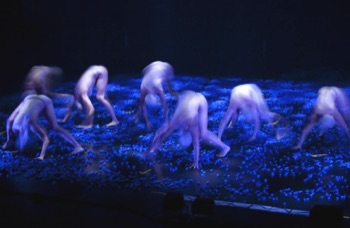
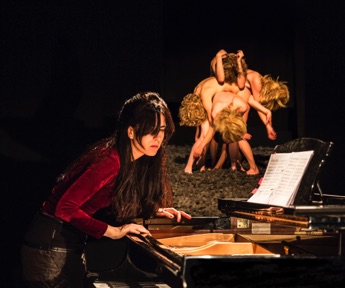
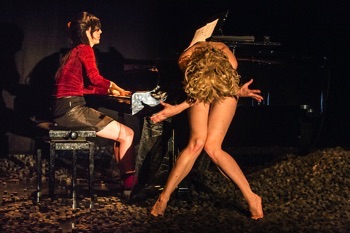
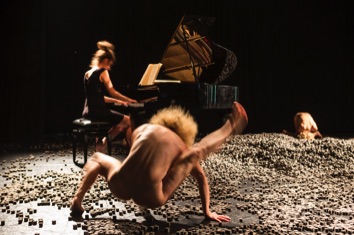
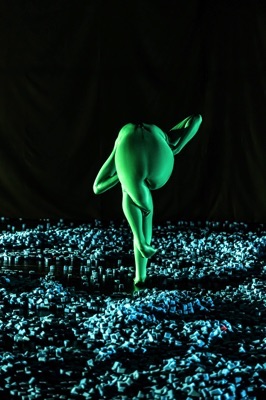
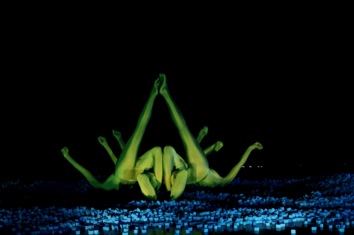
Leopards, Photo: Frenzel
Legforest, Photo: Frenzel
Sculpture, Photo: Frenzel
Küken, Photo: Fellinger
Biene Maja, Photo: Frenzel
Crab, Photo: Frenzel
Superspider, Photo: Braun
